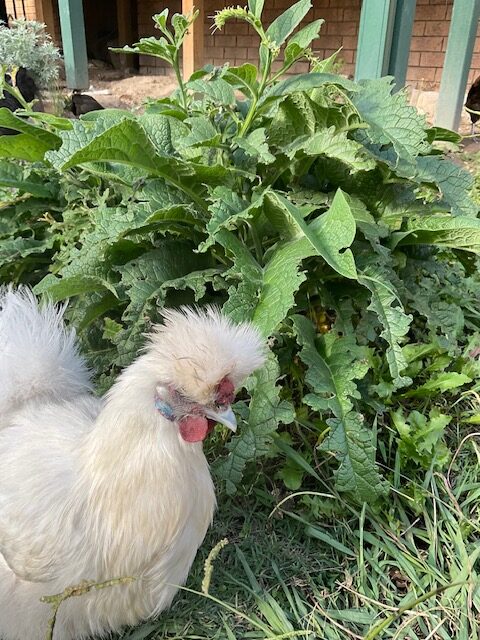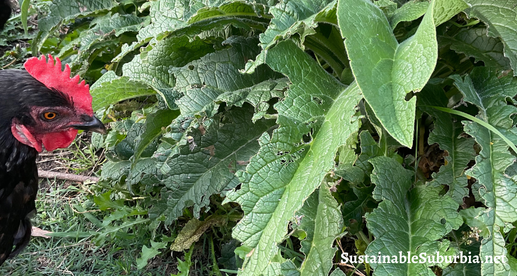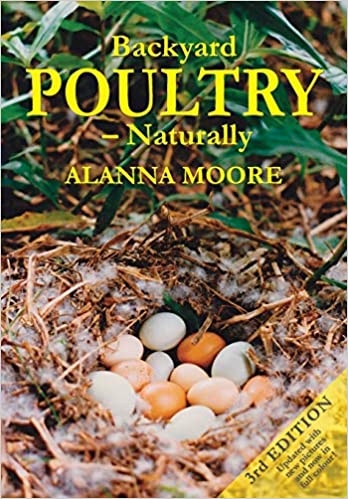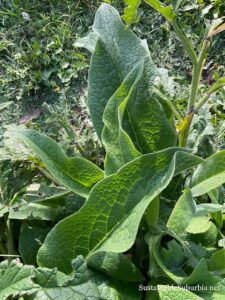Last updated on April 6th, 2023 at 11:16 pm
This is the second post in our new series on growing herbs for a healthy happy chicken run!
Comfrey is a perennial plant with a long history of medicinal and nutritional use. Native to Europe, Asia, and North America, comfrey is now grown in many parts of the world, including Australia.
Comfrey is unusual in that it is a plant source of B12. It is used to treat digestive disorders, as well as a poultice for wounds, sprains, and broken bones because of its allantoin content. It is also a highly nutritious plant that is very easy to grow. Growing comfrey can be beneficial to the health of chickens, as well as provide an additional source of food. It’s also an excellent addition to compost, adding almost as much nitogen as animal manure.
Keep in mind though, that comfrey is considered toxic to humans, and should not be taken by mouth.
What Is Comfrey?
Comfrey is a perennial herb belonging to the Boraginaceae family. It has long, tapering leaves and small, bell-shaped flowers that come in various shades of blue, purple, and pink.
The plant can grow up to 1.5 metres (four feet) tall, and the leaves can reach up to 30cm long.
Comfrey has an astringent, slightly bitter taste and can be used fresh or dried (but should not be eaten by humans).
Comfrey is also super high in silica, so an infusion makes an effective spray for plants with fungal diseases.
Health Benefits Of Comfrey For Chickens
Comfrey is protein rich and a natural source of B12, which can help to prevent anemia, improve fertility, and promote healthy feathers and skin. In addition, comfrey is a good source of dietary fiber, which aids in digestion and helps to keep chickens regular. The essential fatty acids found in comfrey can also help to improve the health of chickens, as well as make their feathers shiny and healthy.
Comfrey also contains allantoin, which can be beneficial for chickens, especially those with skin conditions. Allantoin is an anti-inflammatory and anti-bacterial compound that can help to soothe and heal skin irritations, rashes, and other ailments.
Comfrey Poultice
A comfrey poultice can be used to treat broken bones, sprains, and other soft tissue injuries. To make a poultice, simply pulverise fresh or dried comfrey leaves in a blender with some warm water and (optionally) Epsom salts. You want to create a thick paste. Apply the paste directly to the affected area, wrap it in a cloth, and leave for up to one hour. This will help to reduce pain and swelling. Comfrey poultices can be used on both humans and animals.
Using Comfrey in Chicken Feed
Comfrey can also be used as a supplement in chicken feed. Simply add fresh or dried comfrey leaves to the chicken’s grain mixture; this will provide them with essential nutrients while they peck away at the food.
It can also be offered as a treat when mixed with cracked corn, oats, barley, or wheat germ. As always, monitor your chickens’ health if you introduce any new food into their diet.
Alternatively, simply plant them where the chickens have easy access to snack on them.
How To Grow Comfrey In A Chicken Run

Growing comfrey in a chicken run is easy, as long as you give it a chance to become established before the chickens scratch it up. The first step is to obtain some comfrey seedlings or root cuttings. Comfrey in Australia is generally sterile and cannot be grown by seed, but it grows very easily by root cutting.
Comfrey prefers a well-draining soil that is slightly acidic. If the soil is too alkaline, you can add sulfur to lower the pH. If your are planting several seedlings or root cuttings, plants them around 50-60cm apart. Water well after planting.
Once established (about a year), according to Alanna Moore, leaves can be harvested daily, and the leaves can be used fresh or dried. However, comfrey is frost sensitive, so depending on your location, it may die back in winter. Don’t worry, it will regrow in spring. If you let them get old, the stems will need to be mulched (though they are also an excellent addition to your compost).
Useful Resources
In addition to Alanna Moore’s Backyard Poultry Naturally, my go-to reference books are Jackie French’s The Chook Book and Backyard Self Sufficieny, Linda Woodrow’s The permaculture home garden (one of my all-time favourite books) and The Canberra Gardener.




